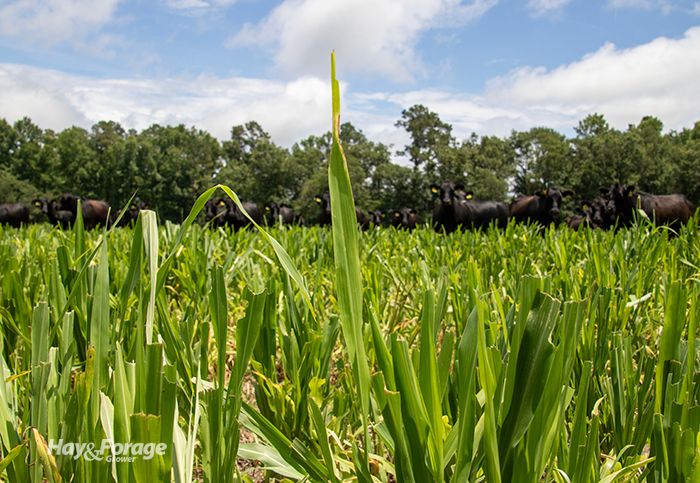
Annual forages can be valuable tools for livestock producers who want to diversify their forage resources and bolster their feed supplies. They are especially useful to extend the grazing season in either direction and secure quality feed when perennial cool-season forages go dormant during the summer.
Just like no two growing seasons are exactly alike, though, no two farms are exactly the same. An annual forage program that works for one operation may not be successful for another. Therefore, in addition to considering weather conditions and plant growth curves, selecting cool- and warm-season species that suit an individual farm will be necessary to integrate them into a cropping system effectively.
There are many lessons to be had by diving in and learning by doing, but bouncing ideas off of other producers offers new perspectives as well. This type of collaboration can help farmers use annual forages to their advantage, even if a particular practice isn’t one-size-fits-all.
In a recent University of Nebraska Extension webinar, Mary Drewnoski introduced two producers from the Corn Husker State who both include annual forages in their crop rotations, albeit in different ways. After comparing their species selection, harvest management, growing environment, and operation size, they discussed how their objectives for planting annual forages are ultimately inspired by similar goals.
A work in progress
Doug Steffen has a row crop farm in the northeast corner of Nebraska near the small town of Crofton. He started growing annual forages for his 70-cow herd to diversify forage resources, enhance stand density, and build a system that could support more intensive grazing.
“Different crops give me different opportunities, and anything that will give me the ability to come back and graze it — or build biomass and cover on the land — is where I see a lot of potential,” Steffen said.
One of Steffen’s strategies is to plant an early season crop like field peas in the spring that is harvested for grain. Then, he interseeds sorghum-sudangrass in these fields in the summer to be grazed by weaned calves in the fall.
Steffen has also seeded a diverse mix of vetch, brassicas, and rape for spring grazing, and he plants cereal rye after corn harvest for the same purpose; however, he doesn’t plant all of these acres at once. He intermittently seeds cereal rye so not all paddocks grow at the same rate and reach maturity at the same time. Steffen said this approach is a work in progress, but it is one that has offered more flexibility in his grazing schedule.
“I’m using different seeding dates to help me manage my grazing because if you plant all your rye at the same time, it is all ready at the same time,” he explained. “Once it heads out, [cattle] don’t want to graze it.”
Steffen aims to reduce input costs on his farm, including those spent on chemical weed control. He also believes that all plants — including weeds — play a role in plant communities and soil biology, which makes him think twice about spraying herbicide. Instead, he grazes cattle at a higher stocking density so they are more likely to eat less desirable species since they cannot be as selective.
“The smaller you make [paddocks], the more competitive the livestock are going to be in that area, and they are going to graze more effectively,” Steffen asserted. “Cattle are a tool for me that I can control and make sure they are grazing weeds.”
Three crops in one year
The same reasons for growing annual forages resonated with Lance Schutte, even though he farms on a much larger scale. Schutte is a range and forage manager at the U.S. Meat Animal Research Center located three hours south of Crofton in Clay Center, Neb., and he plants annual forages on 700 to 900 acres every year.
After harvesting corn or soybeans in the fall, Schutte typically seeds cereal rye to be chopped for ryelage in the spring. He follows this up with sorghum-sudangrass that is also chopped for silage in the summer, and then plants a mix of oats, rapeseed, and grazing corn that stockers or replacement heifers strip graze through the fall and winter. Schutte said mechanically harvesting the first two crops is necessary to maximize plant growth throughout the year in his triple-crop system.
“Our growing season is April 15 to October 15. If we get delayed a week in August or September, our backs are up against a wall on growing degree days,” he said. “Being able to optimize those growing degree days is vitally important.”
Having this variety of feed options essentially buffers forage shortages due to drought. In fact, Schutte is planning on seeding foxtail millet instead of sorghum-sudangrass this year to replenish dry hay supplies on his farm that have dwindled due to dry weather. He noted foxtail millet tends to dry down faster than sorghum-sudangrass and produces roughly 2 to 2.5 tons of dry matter per acre.
A major lesson Schutte has learned from growing annual forages is to terminate cereal rye after cutting and chopping instead of letting it regrow. He has found the regrowth interferes with summer annual establishment and negatively affects forage quality of the second harvest. Schutte also aims to improve his watering system for grazing livestock. He currently has stationary tanks installed in pastures, but he stated that portable waterers, like the ones Steffen uses, would be more efficient for strip grazing annual forages.
In closing, Drewnoski affirmed that there are myriad ways to construct an annual forage program, but crops should be selected and utilized in a way that aligns with an operation’s goals. Even with different forage species, crop rotations, and harvest techniques, though, the same principles of forage and grazing management apply across the board.
“There are a lot of different things you can do with annuals — it really depends on what you want to achieve,” the beef systems specialist concluded.

